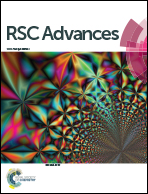Effect of alkyl substituents in BODIPYs: a comparative DFT computational investigation†
Abstract
Random changes in the alkyl substitution patterns of fluorescent dyes, e.g. BODIPYs, are often accompanied by significant changes in their photophysical properties. To understand such alterations in properties in closely related molecular systems, a comparative DFT (density functional theory) computational investigation was performed in order to comprehend the effects of alkyl substitution in controlling the structural and electronic nature of BODIPY dyes. In this context, a systematic strategy was utilized, considering all possible outcomes of constitutionally-isomeric molecules to understand the alkyl groups’ effects on the BODIPY molecules. Four different computational methods {i.e. B3LYP/6-31G(d); B3LYP/6-311++G(d,p); wb97xd/6-311++G(d,p) and mpw1pw91/6-311++G(d,p)} were employed to rationalize the agreement of the trends associated with the molecular properties. In line with experimental observations, it was found that alkyl substituents in BODIPY dyes situated at 3/5-positions effectively participate in stabilization as well as planarization of such molecules. Screening of all the possible isomeric molecular systems was used to understand the individual properties and overall effects of the typical alkyl substituents in controlling several basic properties of such BODIPY molecules.


 Please wait while we load your content...
Please wait while we load your content...